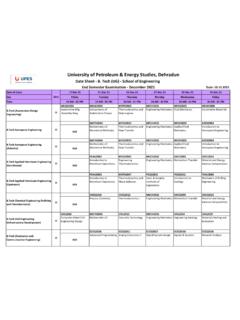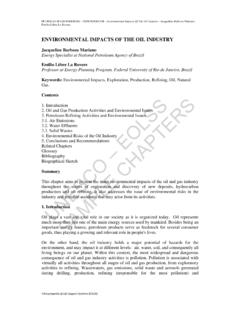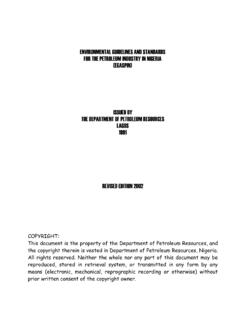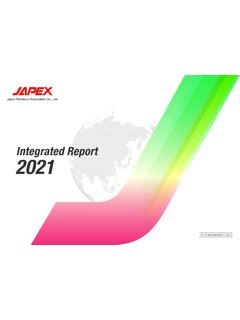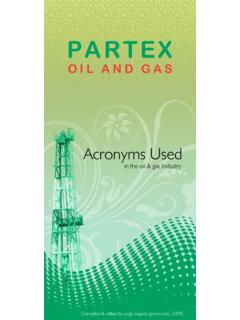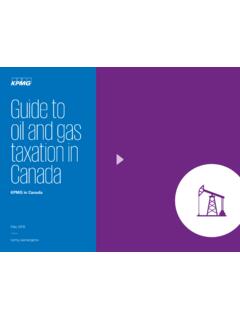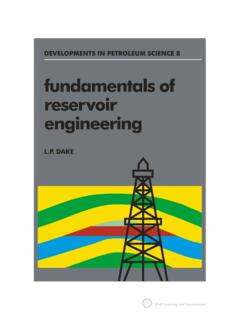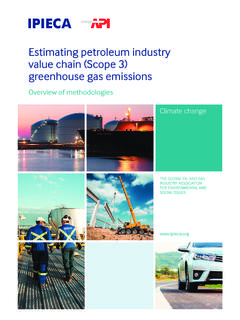Transcription of AN OVERVIEW OF OFFSHORE OIL AND GAS EXPLORATION …
1 Department of Trade and IndustryAN OVERVIEW OF OFFSHORE OIL AND GASEXPLORATION AND production ACTIVITIESAUGUST of EXPLORATION and production ActivitiesAugust 2001 Page 1 DTI and Structure of the 32AN OVERVIEW OF OFFSHORE 33 EXPLORATION AND sources of and appraisal objectives and and suspension and sources of 124 FIELD and types of production 16 OVERVIEW of EXPLORATION and production ActivitiesDTI SEAPage 2 August sources of sources of 215 production water and other aqueous and utility and sources of 247 GLOSSARY & 258 SOME FURTHER 29 OVERVIEW of EXPLORATION and production ActivitiesAugust 2001 Page 3 DTI document is intended to provide an introduction for non-specialists to the key activitiesand potential sources of environmental effects associated with oil and gas EXPLORATION andproduction.
2 It forms part of the information base for the DTI s Strategic EnvironmentalAssessment process which aims to facilitate public and other consultation on the potentialimplications of future licensing of OFFSHORE areas of the United Kingdom Continental and Structure of the DocumentThe main stages and activities associated with the EXPLORATION , development and productionof OFFSHORE oil and gas resources are summarised in Figure 1 1 Oil and Gas EXPLORATION and Development Stages and ActivitiesSeismicExp lorat ion App raisalDevelopmentDevelop mentDrillingConcept/Basis of Design/Detailed Design DesignProcure/ Fabricate/Const ruc t/CommissionDe vel opProduc tion/P rocessing/ Exp ortOp e r a t eD ec o mmissionE xpl or at ion &Appra isalDe vel opm en tOpera tio nsDecom nLic en sin gSeismicSeismicExp lorat ion App raisalDevelopmentDevelop mentDrillingExp lorat ion App raisalDevelopmentDevelop mentDrillingConcept/Basis of Design/Detailed Design DesignConcept/Basis of Design/Detailed Design
3 DesignProcure/ Fabricate/Const ruc t/CommissionDe vel opProcure/ Fabricate/Const ruc t/CommissionDe vel opProduc tion/P rocessing/ Exp ortOp e r a t eProduc tion/P rocessing/ Exp ortOp e r a t eD ec o mmissionD ec o mmissionE xpl or at ion &Appra isalDe vel opm en tOpera tio nsDecom nLic en sin gThe document is structured so that each major stage is summarised in a separate sectionalong with its associated activities and potential sources of environmental with other specialist areas, there are a number of terms and acronyms peculiar tothe oil and gas industry to aid understanding a combined glossary and abbreviations list isprovided at the end of the document.
4 While the summary is a stand alone document, for thecurious, some suggestions for further reading are OVERVIEW OF OFFSHORE LICENSINGE xploration and production in the oil and gas industry is regulated primarily through alicensing system managed by the DTI Oil and Gas Directorate's EXPLORATION and LicensingBranch. A brief OVERVIEW of the OFFSHORE or Seaward licensing process is given below,more detail can be found on the DTI s website of EXPLORATION and production ActivitiesDTI SEAPage 4 August 2001 The first OFFSHORE licensing round took place in 1964 and the first significant discovery of gaswas made in the southern North Sea in 1965 and oil was discovered four years later in thecentral North Sea.
5 Seaward licensing rounds have been held roughly every two years since1964 with the last, the nineteenth being held in 2000/2001. In January 2000, there were 109oil fields, 87 gas fields and 16 condensate fields in production Act 1998, entered into force in 1999 and consolidated a number of provisionspreviously contained in five earlier pieces of primary legislation. The Act vests ownership ofoil and gas within Great Britain and its territorial sea in the Crown, and gives Governmentrights to grant licences to explore for and exploit these resources and those on the UKContinental Shelf (UKCS). Regulations set out how applications for licences may be made,and specify the Model Clauses to be incorporated into the are two types of Seaward Licences: EXPLORATION Licenceswhich are non-exclusive, permit the holder to conduct non-intrusive surveys, such as seismic or gravity and magnetic data acquisition,over any partof the UKCS that is not held under a production Licence.
6 Wells may be drilled underthese licences, but must not exceed 350 metres in depth without the approval of theSecretary of State. These licences may be applied for at any time and are granted toapplicants who have the technical and financial resources to undertake such work. Eachlicence is valid for three years, renewable at the Secretary of State s discretion for onefurther term of three years. EXPLORATION licence holders may be commercial geophysicalsurvey contractors or licence Operators. A commercial contractor acquiring data overunlicensed acreage may market such data. production Licencesgrant exclusive rights to holders to search and bore for, and get,petroleum , in the area of the licence covering a specified block or blocks.
7 For licensingpurposes the UKCS is divided into quadrants of 1 of latitude by 1 of longitude (exceptwhere the coastline, bay closing line or a boundary line intervenes). Each quadrant isfurther partitioned into 30 blocks each of 10 x 12 minutes. The average block size isabout 250 square km (roughly 100 square miles). Relinquishment requirements onsuccessive licences have created blocks subdivided into as many as six part blocks insome mature areas. production Licences are usually issued in periodic LicensingRounds , when the Secretary of State for Trade and Industry invites applications inrespect of a number of specified blocks or other activities carried out under a EXPLORATION or production Licence require the consent ofthe Secretary of State and may require compliance with other legislative provisions andspecific conditions attached to the AND purpose of EXPLORATION activity is to identify commercially viable reserves of oil and conditions necessary for such reserves to have accumulated are complex and largelydependent on past geological history and present geological formations and structures.
8 Forthe deposits to occur, particular combinations of potential source and reservoir rockstogether with migration pathways and trap structures are needed. Finding such reservoirsOverview of EXPLORATION and production ActivitiesAugust 2001 Page 5 DTI SEAand estimating the likelihood of them containing oil and gas is a technically complex processrequiring the use of a range of techniques. Such techniques include deep and shallowgeophysical (seismic) surveys, shallow drilling and coring, aero-magnetic/gravity surveysand EXPLORATION and appraisal on a general geological understanding, broad areas of the earth have been identifiedas prospective, with the potential to contain reserves of oil and gas.
9 Prospective areas arefurther defined using surface/shallow mapping techniques and geophysical (seismic) surveysto aid understanding of deeper, subsurface geology. Aero-magnetic and gravity surveys areuseful in defining general structure such as sedimentary basins but not for pinpointing areaswith potential oil and gas. Areas of potential interest are subjected to further geophysicalstudy, which may involve reinterpreting existing seismic data or conducting new only reliable way to determine whether the identified formations contain hydrocarbons isto drill into them. However, the decision to drill is not taken solely on geological requirements, economic factors (drilling costs, transport costs, marketopportunities, relative merit/financial risk) and technical feasibility (including safety andenvironmental considerations)
10 Are all factored into the surveysSurface techniques do not allow reliable extrapolation as to the subsurface other methods may be used for reconnaissance, seismic survey techniques remainthe most effective method of developing an understanding of the deep geology of an surveys are based on the same principles used to record data on subsurfacegeology during earthquakes but utilise a much smaller man-made energy source to generateenergy waves which are directed into the earth s crust. Some of these energy waves arereflected or refracted back from geological structures deep beneath the surface and picked-up by sensitive detectors (geo- or hydrophones).










